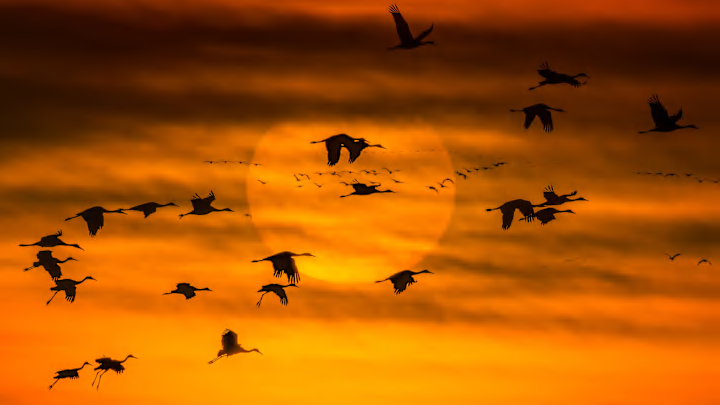Every fall, millions of birds take to the sky above North America. They aren’t all traveling to the same destination, but many are heading the same direction: south. There are several reasons why migratory birds ditch the northern latitudes once the temperatures start to dip.
How Do Birds Know When to Migrate?

Migratory reflex and navigational skills appear to be written in their genes. Captive birds have been observed getting pretty fidgety and changing their sleep patterns right before their natural migration time. Ethologists—those who study animal behavior—call the birds' behavior zugunruhe (“migratory restlessness”).
Captive birds display zugunruhe even if they’re not exposed to natural light or to seasonal temperature changes. Many of these birds will orient themselves in the direction that they would normally be traveling at that time of year. Researchers say that the fact that the birds know both when and where to migrate without environmental clues suggests that genes, and a biological calendar written into them, play a role in migration.
How Do Migrating Birds Navigate?
Genes are all well and good to get them started, but how do birds navigate once they get up in the air? The prevailing theory is that the Earth’s magnetic field plays a large part. Over the last few years, scientists have discovered tiny bits of magnetite (a magnetic mineral) in the brains of several animal species, including birds, bats, whales and dolphins. The magnetite could enable the animals to use the Earth’s magnetic fields as a migration guide, but the research is just scratching the surface. Now that we know that birds and other animals could detect magnetic fields and have explored the mechanisms by which they could do it, further research will need to tackle the question of how the animals gather information from the magnetic field, process it, and use it to navigate.
Studies have shown that migratory birds also use celestial navigation to find their way around in the dark. Captive birds placed in a planetarium changed their directional orientation when the star pattern on the ceiling shifted and became confused when the images of stars were dimmed, suggesting that birds use the layout of constellations in the sky as a compass.
Why Do Birds Migrate?

But why migrate in the first place? And why do birds bother flying back north once they’ve reached a warmer locale? It’s fairly simple: the search for food. While birds might be hard-wired to migrate at certain times of the year, a 2007 study concluded birds won’t make the trip without certain physiological and environmental cues, the most important being the scarcity of food. Birds fly south in the winter in search of alternate food sources, and even though their summer home might be nicer, they return home in the spring when their usual food stocks are replenished. If there’s still food to be had at either place, though, some birds will delay migration or won’t bother leaving at all, choosing instead to band together in flocks to forage.
Have you got a Big Question you'd like us to answer? If so, let us know by emailing us atbigquestions@mentalfloss.com.
Read More Stories About Birds Here:
A version of this story originally ran in 2008; it has been updated for 2024.
